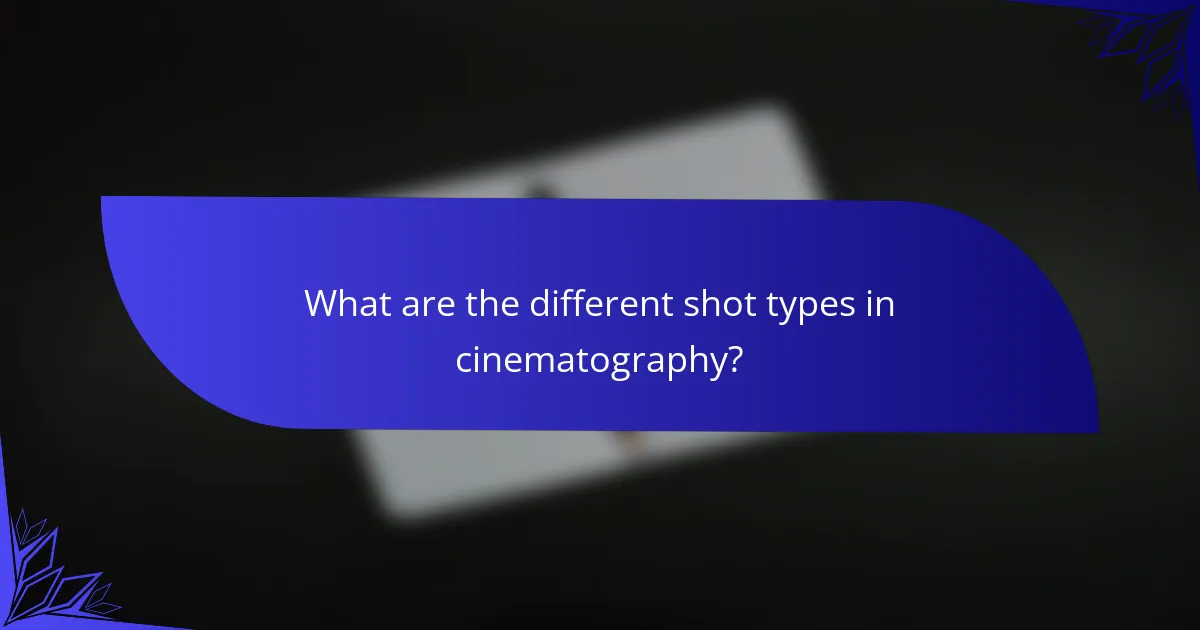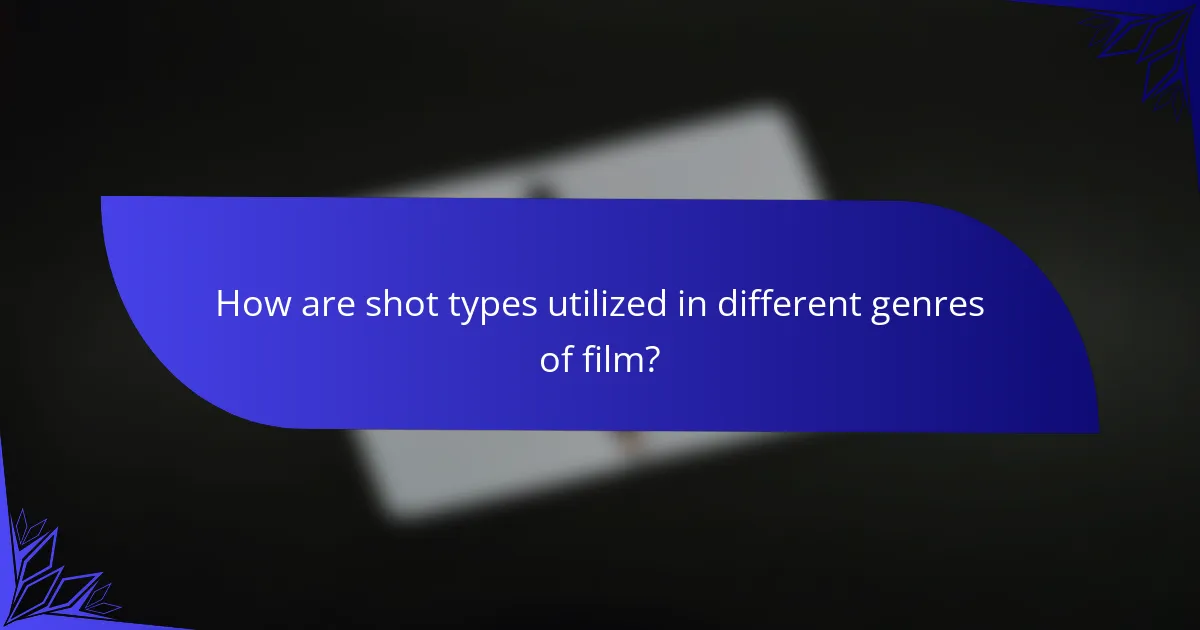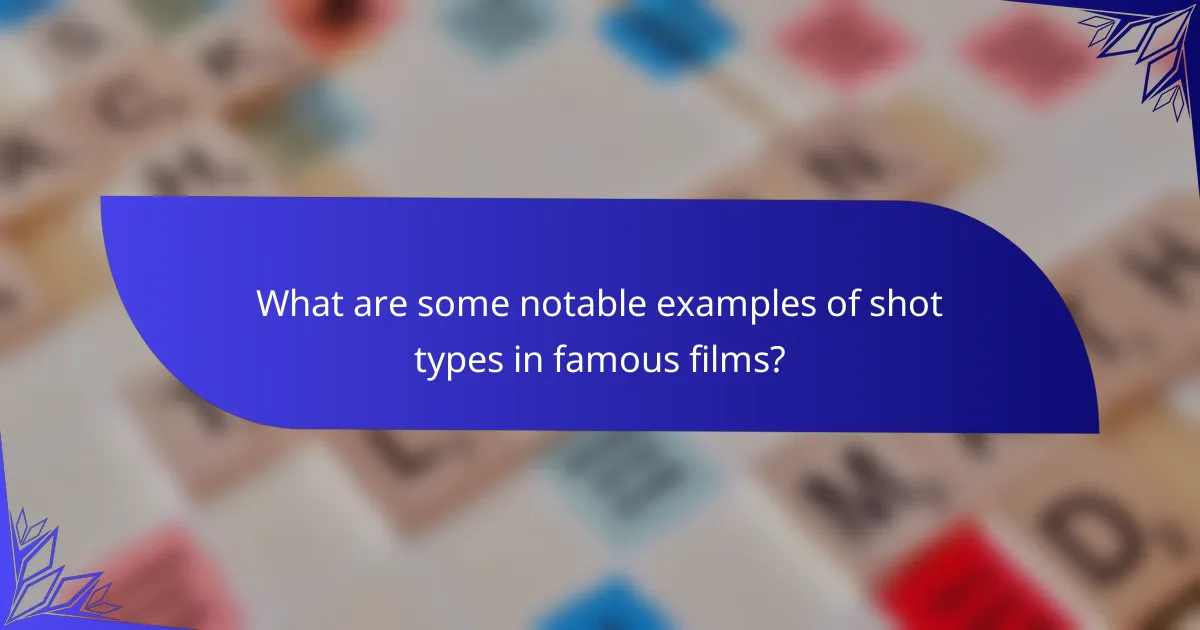Shot types in cinematography refer to the various framing techniques used to capture scenes, including wide shots, medium shots, close-ups, and extreme close-ups. Each shot type serves distinct purposes in storytelling, such as establishing context, highlighting emotions, or creating intensity. The article explores the characteristics and applications of these shot types across different film genres, illustrating how they enhance narrative and viewer engagement. Notable examples from famous films demonstrate the effective use of shot types, showcasing their impact on visual storytelling and emotional resonance. Understanding these fundamentals is essential for anyone interested in the art of filmmaking.

What are the different shot types in cinematography?
There are several different shot types in cinematography. Common shot types include the wide shot, medium shot, close-up, and extreme close-up.
A wide shot captures a large area, showcasing the environment and the characters within it. This shot establishes context and location.
A medium shot focuses more closely on the subject, typically showing the torso and head. It balances the subject and background, allowing for dialogue and interaction.
A close-up emphasizes the subject’s face or a specific detail. This shot conveys emotions and reactions effectively.
An extreme close-up zooms in on a particular feature, such as an eye or an object. This shot creates intensity and draws attention to specific elements.
Other shot types include the over-the-shoulder shot, which shows the perspective of a character, and the two-shot, featuring two characters in the frame.
These shot types serve various purposes, allowing filmmakers to convey narrative and emotion effectively.
How do shot types influence storytelling in film?
Shot types significantly influence storytelling in film by shaping viewer perception and emotional response. Different shot types, such as wide shots, close-ups, and medium shots, serve distinct narrative functions. Wide shots establish context and setting, providing a sense of space. Close-ups focus on characters’ emotions, enhancing audience connection. Medium shots balance action and character interaction, facilitating dialogue.
For instance, a close-up of a character’s face can convey tension or vulnerability, impacting audience empathy. Conversely, a wide shot can depict isolation or community, affecting the story’s mood. Research by Bordwell and Thompson in “Film Art: An Introduction” illustrates how shot composition directly correlates with narrative clarity and emotional engagement. Thus, shot types are essential tools in visual storytelling, guiding the audience’s understanding and emotional journey.
What are the emotional impacts of various shot types?
Various shot types in cinematography evoke distinct emotional responses from the audience. Close-up shots create intimacy and connection, allowing viewers to engage deeply with a character’s emotions. Medium shots provide context and balance, often eliciting feelings of understanding and relatability. Wide shots can evoke feelings of isolation or grandeur, depending on the composition and subject matter. High-angle shots tend to make subjects appear vulnerable, while low-angle shots can instill a sense of power or dominance. Tracking shots can generate excitement and anticipation, while static shots may create tension or contemplation. Research indicates that the emotional impact of shot types is linked to audience perception and psychological engagement, influencing how stories are experienced on screen.
How do shot types affect audience perception?
Shot types significantly influence audience perception by shaping emotional responses and narrative engagement. Different shot types convey varying degrees of intimacy, tension, and context. For example, close-up shots create a sense of intimacy and connection with characters, allowing viewers to empathize with their emotions. Conversely, wide shots establish context and setting, which can evoke feelings of isolation or grandeur. Research indicates that shot composition can manipulate viewer focus and emotional reactions, reinforcing the narrative. Studies show that specific shot types can enhance suspense or surprise, impacting how audiences interpret scenes. Thus, the choice of shot type is critical in guiding audience perception and emotional involvement in the story.
What are the primary categories of shot types?
The primary categories of shot types in cinematography include wide shots, medium shots, and close-ups. Wide shots capture a large area and establish the setting. They often show the subject in relation to their environment. Medium shots focus on the subject from the waist up. This type balances the subject and background. Close-ups emphasize [censured] expressions and details. They create intimacy and highlight emotions. Other categories include extreme wide shots, which provide a broader context, and extreme close-ups, which zoom in on specific features. Each shot type serves a distinct purpose in storytelling and visual composition.
What is the significance of wide shots in cinematography?
Wide shots in cinematography are significant for establishing context and spatial relationships. They provide a comprehensive view of the scene, allowing the audience to understand the environment and character positioning. This type of shot is often used at the beginning of a sequence to set the tone and location. Wide shots can also enhance storytelling by showcasing the scale of the action or the isolation of characters. They create a visual narrative that can evoke emotions, such as loneliness or grandeur. Historical films frequently employ wide shots to depict vast landscapes or battle scenes effectively. Overall, wide shots are essential tools for visual storytelling in film.
How do medium shots serve narrative purposes?
Medium shots serve narrative purposes by balancing character and environment. They typically frame a subject from the waist up. This allows viewers to see [censured] expressions and body language clearly. Medium shots establish context within the scene. They create a connection between characters and their surroundings. This shot type is effective for dialogue scenes. It maintains visual engagement while conveying emotional depth. Studies show that medium shots enhance storytelling by fostering audience empathy. They provide essential visual information without overwhelming the viewer.
What role do close-ups play in character development?
Close-ups play a crucial role in character development by enhancing emotional connection and providing insight into characters’ thoughts. They allow audiences to see subtle [censured] expressions and emotions that reveal internal conflicts. This visual intimacy fosters empathy, as viewers can directly experience a character’s feelings. Close-ups can emphasize pivotal moments, highlighting decisions or reactions that define a character’s arc. For instance, in films, a close-up of a character’s tearful face can signify vulnerability, deepening audience engagement. This technique is widely used in storytelling to create memorable character moments that resonate with viewers.

How are shot types utilized in different genres of film?
Shot types are utilized in different genres of film to convey specific emotions and narratives. In action films, wide shots are often used to showcase stunts and choreography. Close-ups in drama films highlight character emotions and reactions. Horror films frequently employ extreme close-ups to create tension and fear. Comedies may use medium shots to capture interactions and comedic timing. Documentaries often utilize long shots to provide context and establish settings. Each genre leverages shot types to enhance storytelling and viewer engagement. This strategic use of cinematography aligns with established filmmaking conventions.
What shot types are commonly used in action films?
Common shot types used in action films include wide shots, close-ups, and medium shots. Wide shots establish the setting and context, often showcasing expansive action sequences. Close-ups focus on characters’ emotions and reactions, enhancing dramatic moments. Medium shots balance both character and background, providing context while maintaining character visibility. Action films frequently utilize tracking shots to follow movement and create a dynamic viewing experience. Over-the-shoulder shots are also common, emphasizing the perspective of characters during confrontations. These shot types enhance storytelling and engage the audience in the action.
How do shot types enhance tension in thrillers?
Shot types enhance tension in thrillers by manipulating viewer perception. Close-ups create intimacy and focus on characters’ emotions. This draws the audience into the psychological state of the character. Wide shots can convey isolation, amplifying the character’s vulnerability. High-angle shots often depict characters as weak or threatened, increasing suspense. Conversely, low-angle shots can instill a sense of power in antagonists, heightening fear. Quick cuts between shot types can create a disorienting effect, maintaining a fast-paced tension. The strategic use of shot types is crucial in building suspenseful narratives, as seen in films like “Psycho” and “Se7en.”
What are the typical shot types found in romantic films?
Typical shot types found in romantic films include close-ups, medium shots, and wide shots. Close-ups highlight characters’ emotions and reactions, enhancing intimacy. Medium shots often show interactions between characters, providing context and space. Wide shots establish the setting and mood, creating a backdrop for romance. These shot types are commonly used to convey feelings and relationships. For example, close-ups can capture a character’s longing gaze, while wide shots can depict a romantic landscape. The combination of these shots helps to tell a compelling romantic narrative.
What techniques can filmmakers use to combine shot types effectively?
Filmmakers can use techniques such as matching action, cutaways, and transitions to combine shot types effectively. Matching action involves cutting between shots while maintaining the same action, creating a seamless flow. Cutaways are used to show related content, enhancing context without losing the main narrative. Transitions, such as fades and wipes, can help in shifting between different shot types smoothly. These techniques help maintain continuity and engage the audience. Effective combination of shot types can create a dynamic visual storytelling experience.
How does shot composition influence visual storytelling?
Shot composition significantly influences visual storytelling by shaping the audience’s perception and emotional response. Effective shot composition guides viewer attention to key elements within a scene. It establishes context and mood through framing, angles, and depth. For instance, a close-up shot can evoke intimacy or tension, while a wide shot can convey isolation or grandeur. Additionally, the rule of thirds helps create balanced and engaging visuals, enhancing narrative clarity. Research shows that well-composed shots can increase viewer engagement and comprehension of the story being told. Overall, shot composition is crucial for conveying themes and emotions effectively in visual narratives.
What is the role of transitions between shot types?
Transitions between shot types serve to guide the viewer’s emotional response and understanding of the narrative. They create visual continuity and maintain the flow of the story. Effective transitions can enhance pacing and emphasize key moments. For instance, a cut from a close-up to a wide shot can reveal context that deepens the audience’s engagement. According to film theory, transitions help establish relationships between characters and settings. They can also signify changes in time or perspective, adding layers to the storytelling. Smooth transitions contribute to a cohesive viewing experience, keeping the audience immersed in the film.

What are some notable examples of shot types in famous films?
Notable examples of shot types in famous films include the close-up, long shot, and tracking shot. The close-up is famously used in “Psycho” to emphasize Marion Crane’s expression during the shower scene. Long shots are utilized in “Lawrence of Arabia” to showcase vast landscapes. Tracking shots are effectively employed in “Goodfellas” to follow characters through a bustling restaurant. Each shot type serves a specific purpose in storytelling and visual impact.
How do iconic films utilize shot types to convey themes?
Iconic films utilize shot types to convey themes by strategically selecting framing and angles that emphasize narrative elements. For instance, close-up shots often highlight characters’ emotions, deepening viewer connection. Wide shots can establish context and setting, framing the characters within their environment. Low-angle shots may portray power dynamics, making subjects appear dominant or heroic. Conversely, high-angle shots can suggest vulnerability or weakness. Films like “The Godfather” use these techniques to enhance themes of power and family loyalty. Similarly, “Psycho” employs close-ups and extreme angles to evoke suspense and fear. This intentional use of shot types effectively reinforces the underlying messages of the films.
What can we learn from the shot types used in classic cinema?
Shot types in classic cinema reveal essential storytelling techniques. They demonstrate how framing influences audience perception. For example, close-ups convey emotion and intimacy. Wide shots establish context and setting. Classic films often used these techniques to enhance narrative depth. Directors like Alfred Hitchcock effectively employed shot types for suspense. The use of shot types contributes to visual language in filmmaking. Understanding these elements enriches appreciation of cinematic art.
How do contemporary films innovate with shot types?
Contemporary films innovate with shot types by utilizing advanced technology and creative techniques. Filmmakers employ drones and stabilizers for dynamic aerial shots. This allows for unique perspectives that were previously difficult to achieve. Additionally, the use of virtual reality and 360-degree cameras creates immersive experiences. Filmmakers also experiment with unconventional angles and framing to evoke emotions. For example, extreme close-ups can heighten tension. Moreover, the integration of CGI allows for imaginative shot types that blend reality with fantasy. These innovations enhance storytelling and engage audiences in new ways.
What are best practices for selecting shot types in cinematography?
Best practices for selecting shot types in cinematography include understanding the narrative context and emotional tone. Each shot type conveys specific information and feelings. For example, close-ups highlight emotions, while wide shots establish context. Consider the pacing of the scene; faster cuts may benefit from shorter shot types. Analyze the character dynamics; over-the-shoulder shots can enhance dialogue scenes. Use shot types to guide audience attention effectively. For continuity, maintain consistent shot types across scenes unless a change serves a specific purpose. These practices enhance storytelling and visual coherence in cinematography.
How can filmmakers determine the most effective shot type for a scene?
Filmmakers can determine the most effective shot type for a scene by analyzing the emotional tone and narrative requirements. They should consider the story context and character motivations. Different shot types convey varying feelings; for example, close-ups emphasize emotions, while wide shots establish setting. Filmmakers also evaluate pacing and rhythm, as certain shots can influence the flow of a scene. Additionally, they can reference established cinematographic principles, such as the 180-degree rule, to maintain spatial continuity. Practical experimentation during rehearsals can provide insights into shot effectiveness. Ultimately, collaboration with the director and cinematographer helps refine shot choices, ensuring they align with the overall vision.
What common mistakes should be avoided when using shot types?
Common mistakes to avoid when using shot types include improper framing. Framing should enhance the subject, not distract from it. Another mistake is inconsistent shot sizes. Maintaining continuity in shot sizes helps with narrative flow. Poor lighting can also undermine shot effectiveness. Proper lighting is essential for clarity and mood. Additionally, neglecting shot type variety can lead to visual monotony. Using a mix of shot types keeps the audience engaged. Lastly, ignoring the rule of thirds often results in unbalanced compositions. Following this rule can significantly improve visual appeal.
The main entity of the article is shot types in cinematography, which are essential tools for visual storytelling. The article provides a comprehensive overview of various shot types, including wide shots, medium shots, close-ups, and extreme close-ups, detailing their narrative functions and emotional impacts. It explores how these shot types influence audience perception, enhance character development, and serve different genres of film. Additionally, the article discusses best practices for selecting shot types, common mistakes to avoid, and notable examples from iconic films, offering insights into the significance of shot composition in effective cinematography.